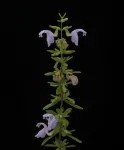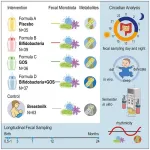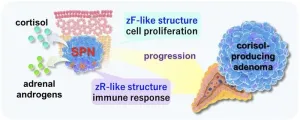(Press-News.org) Scrub mints are among the most endangered plants you’ve probably never heard of. More than half of the 24 species currently known to exist are considered threatened or endangered at the state or federal level, and nearly all scrub mints grow in areas that are being rapidly developed or converted to agricultural pasture.
In a new study, researchers analyzed a distinct type of DNA marker, which shows there are likely more scrub mint species waiting to be scientifically described. And at least one species has been left without federal protection because of a technicality.
“The Titusville balm is currently considered to be a recent hybrid,” said lead author Andre Naranjo, who conducted the study while completing a Ph.D. with the Florida Museum of Natural History. “When you describe something as a hybrid, that implies that it’s not a true species, and it can’t be protected under the Endangered Species Act.”
Naranjo found no evidence for recent hybridization in Titusville balms (Dicerandra thinicola), and his results suggest that a group called the calamints may contain cryptic diversity that requires further study.
Scrub mints evolved during a period of rapid climate change
Naranjo and his colleagues conducted the study to learn about the evolutionary history of scrub mints. The group is native to the southeastern United States and originated during a turbulent time in Earth’s past.
Three million years ago, during a period called the Pliocene, temperatures were 2-3 degrees C warmer than they are today, and sea levels were up to 30 meters higher. At the time, the central and southern half of Florida was an archipelago. But as temperatures cooled over the next several million years, the waters receded, and the Florida Peninsula took on its modern-day dimensions.
Much of this newly surfaced habitat wasn’t exactly prime real estate. Where soils did exist, they were primarily composed of sand, and the cooler temperatures resulted in less rainfall. This was particularly true of the elevated areas that had been islands before sea levels fell.
What’s left of these ancient shorelines is now located near the center of the Florida Peninsula and is often referred to as sand pine scrub. Plants and animals that moved into these vacant spaces had to contend with little water, few nutrients and rampant wildfires.
The species that managed to survive tended to do well within this narrow framework of harsh conditions but lost the ability to live just about anywhere else. Today, 40-60% species that live in these areas are endemic, meaning they can be found only in southeastern scrub habitats.
Scrub mints are among the few plants that staked a claim in the new Florida frontier. Originating in the panhandle, the ancestor of modern scrub mints dispersed south as soon as there was land to grow on.
At the height of the ice ages during the Pleistocene, when much of the planet’s reserve of water was locked away in massive glaciers, Florida was up to twice the size it is today, and scrub mints flourished.
“These plants had a much wider range in the past and were readily sharing DNA with one another,” Naranjo said.
But their habitat soon shrank. There were at least 17 ice ages during the Pleistocene, when scrub mints were evolving, and each cold period was separated by warm intervals in which much of Florida was swallowed by the sea.
Widespread scrub environments were repeatedly reduced to islands, severing the connection between mint populations. They began to grow apart, and soon each scrub island contained its own unique mint species. During the cold periods, when sea levels fell, scrub mint populations again overlapped, and these unique species hybridized with each other.
This ancient intermingling created the scrub mints as they’re known today.
The storied history of scrub mints cut short by development
Naranjo sequenced nuclear DNA from scrub mints for the study. Unlike the plastid DNA often used to study plants, which is produced by structures called chloroplasts, the DNA from plant nuclei is especially useful for scientists trying to tease apart historical interactions between species.
According to his results, annual scrub mints in the genus Dicerandra — which grow north into South Carolina and die back during the winter — originated from a back-to-back hybridization event between the ancestors of perennial scrub mints, which have a distribution further south and grow year-round.
Hybridization is a common form of diversification in plants, so much so that nearly every group of plants you might come across has had a hybridization event occur at some point in its evolutionary history.
Crucially, Naranjo’s findings indicate the scrub mints that currently exist have been on separate evolutionary trajectories for hundreds of thousands of years. When modern humans diverged from Neanderthals around 500,000 years ago, scrub mints were already well on their way to becoming separate species.
The study also suggests that calamints are genetically diverse, so much so that new species designations are likely warranted. This is especially true for those with large ranges in the southeastern U.S., including the scarlet calamint (Clinopodium coccineum) and Georgia calamint (Clinopodium georgianum), neither of which is considered to be endangered.
Even if additional species are afforded protection, Naranjo fears it may not be enough to stave off declines and eventual extinction. Lakela’s mint (Dicerandra immaculata), for example, is listed as critically endangered and only grows along a three-mile stretch of scrub, almost all of which is privately owned.
Conditions that once allowed these plants to thrive, such as periodic wildfires, are now impractical, due to nearby urban areas that would be negatively affected. And invasive species are encroaching on what little pristine scrub is left. Work to remove invasives is often done by volunteers, if they’re removed at all.
“If we continue with business as usual, this entire group of plants could go extinct within the next 100 years. And we won’t just lose these species. We’ll lose the scrub, one of the most truly authentic and formerly ubiquitous Florida habitats will just go away,” Naranjo said.
The study was published in the journal Molecular Phylogenetics and Evolution.
Christine Edwards of the Missouri Botanical Garden, Matthew Gitzendanner of the University of Florida, and Pamela and Douglas Soltis of the Florida Museum of Natural History are also co-authors on the study.
END
These plants evolved in Florida millions of years ago. They may be gone in decades.
2024-04-02
ELSE PRESS RELEASES FROM THIS DATE:
Researchers at CiQUS synthesize new compounds within living cells using light
2024-04-02
Plants harness chlorophyll to capture sunlight and kickstart photosynthesis, a crucial process on our planet that converts luminous energy into chemical fuel while producing oxygen. This pivotal chemical energy is subsequently utilized by plants, algae, and select bacteria to metabolize carbon dioxide and water into sugars.
Now, scientists at the Center for Research in Biological Chemistry and Molecular Materials (CiQUS) have achieved a breakthrough by integrating non-native photosensitizers into mammalian cells. This revelation showcases the capability of these substances to also absorb green ...
Dr. Arati Dasgupta honored by the Nuclear and Plasma Science Society
2024-04-02
WASHINGTON – U.S. Naval Research Laboratory (NRL) plasma physicist, Arati Dasgupta, Ph.D., head, Radiation Hydrodynamics Branch, Plasma Physics Division, receives the 2024 IEEE Plasma Science and Applications Committee (PSAC) Award for her fundamental contributions to, and leadership of, high energy density plasma, atomic, and radiation physics, fusion applications, and service to the plasma science community.
Presented by the IEEE Nuclear and Plasma Sciences Society, the PSAC Award recognizes outstanding contributions to the field of plasma science and engineering. Dasgupta is the 37th winner of the PSAC Award — one of three women ever to receive ...
All-cash home buyers pay 10% less than mortgage buyers
2024-04-02
Owning a home has long been considered a crucial way to build wealth, but making such a purchase has become increasingly difficult for many residents. In addition to steep housing prices and high interest rates, there have been a growing number of all-cash buyers who can close a deal quickly, beating out competing offers from buyers who need to finance their home with a mortgage.
The convenience and certainty of all-cash offers appeals to sellers so much so, that they pay on average 10 % less than mortgage buyers, according to a new study from the University of California San Diego Rady School of Management.
“When sellers accept a mortgage offer, it comes with risk,” said Michael ...
Must mRNA be cloaked in a lipid coat to serve as a vaccine?
2024-04-02
The Uchida Laboratory (Lab Head: Prof. Satoshi Uchida, Department of Advanced Nanomedical Engineering, Medical Research Institute, Tokyo Medical and Dental University; abbreviated as TMDU) of Innovation Center of NanoMedicine (Center Director: Prof. Kazunori Kataoka, Location: Kawasaki, Japan; abbreviated as iCONM) has demonstrated that intradermal administration of mRNA alone (naked mRNA) without protected by nanoparticles induced robust vaccination against SARS CoV-2, a virus causing COVID-19, in mice and primates, ...
Infant gut microbes have their own circadian rhythm, and diet has little impact on how the microbiome assembles
2024-04-02
Infant gut microbiomes oscillate with a circadian rhythm, even when they are cultivated outside of the body. Researchers report April 2 in the journal Cell Host & Microbe that the rhythm is detectable as early as 2 weeks after birth but becomes more pronounced with age. The finding comes from a randomized controlled trial that also showed that diet has less impact on the development and composition of the infant microbiome than previously thought.
“We found that even at very early ages of colonization, the microbial ecosystem develops this circadian rhythmicity,” ...
New study finds triple-negative breast cancer tumors with an increase in immune cells have lower risk of recurrence after surgery
2024-04-02
ROCHESTER, Minn. — A new multicenter, international study suggests that people who have early-stage triple-negative breast cancer (TNBC) and high levels of immune cells within their tumors may have a lower risk of recurrence and better survival rates even when not treated with chemotherapy. The study was published in the Journal of American Medical Association (JAMA).
TNBC is a breast cancer subtype that does not respond to drugs that target the estrogen receptor or the HER2 protein. It grows rapidly, is more likely to spread beyond the breast before diagnosis ...
New insights into how tumors on adrenal glands develop
2024-04-02
Fukuoka, Japan—Researchers from Kyushu University's Faculty of Medical Sciences report on new insights into the mechanisms of how adrenal gland tumors are formed. The team identified a new type of tumor cell population that they termed 'steroids-producing nodules' or SPNs, that exhibits the unique characteristic of producing two different hormones. Specific structures in SPNs were found to lead to cortisol-producing adenomas, or CPAs, noncancerous tumors that produce excessive cortisol.
Their findings, published in eBioMedicine, ...
Ask Chat GPT about your radiation oncology treatment
2024-04-02
· AI responses to common patient questions were on par or exceeded answers from professional societies
· Goal also to reduce clinician workload and burnout
· More than 60% of cancer patients require radiation oncology treatment
CHICAGO --- Cancer patients about to undergo radiation oncology treatment have lots of questions. Could ChatGPT be the best way to get answers?
A new Northwestern Medicine study tested a specially designed ChatGPT to see if it could successfully provide answers to patients’ common questions about radiation oncology. Patients may be too overwhelmed to address all their concerns during a clinical visit ...
Surveillance colonoscopy findings in older adults with a history of colorectal adenomas
2024-04-02
About The Study: In this study of 9,740 surveillance colonoscopies among 9,601 adults ages 70 to 85 with prior colorectal adenoma, colorectal cancer detection was rare regardless of prior adenoma finding, whereas the advanced neoplasia yield was 12% overall. Yields were higher among those with a prior advanced adenoma than among those with prior nonadvanced adenoma and did not increase significantly with age. These findings can help inform whether to continue surveillance colonoscopy in older adults.
Authors: Jeffrey K. Lee, M.D., M.P.H., of Kaiser Permanente Northern California in Oakland, is the corresponding author.
To access the embargoed study: ...
Metabolic profile and long-term risk of depression, anxiety, and stress-related disorders
2024-04-02
About The Study: High levels of glucose and triglycerides and low levels of high-density lipoprotein were associated with future risk of depression, anxiety, and stress-related disorders in this study of more than 200,000 participants. These findings may support closer follow-up of individuals with metabolic dysregulations for the prevention and diagnosis of psychiatric disorders.
Authors: Charilaos Chourpiliadis, M.D., of the Karolinska Institutet in Stockholm, is the corresponding ...





